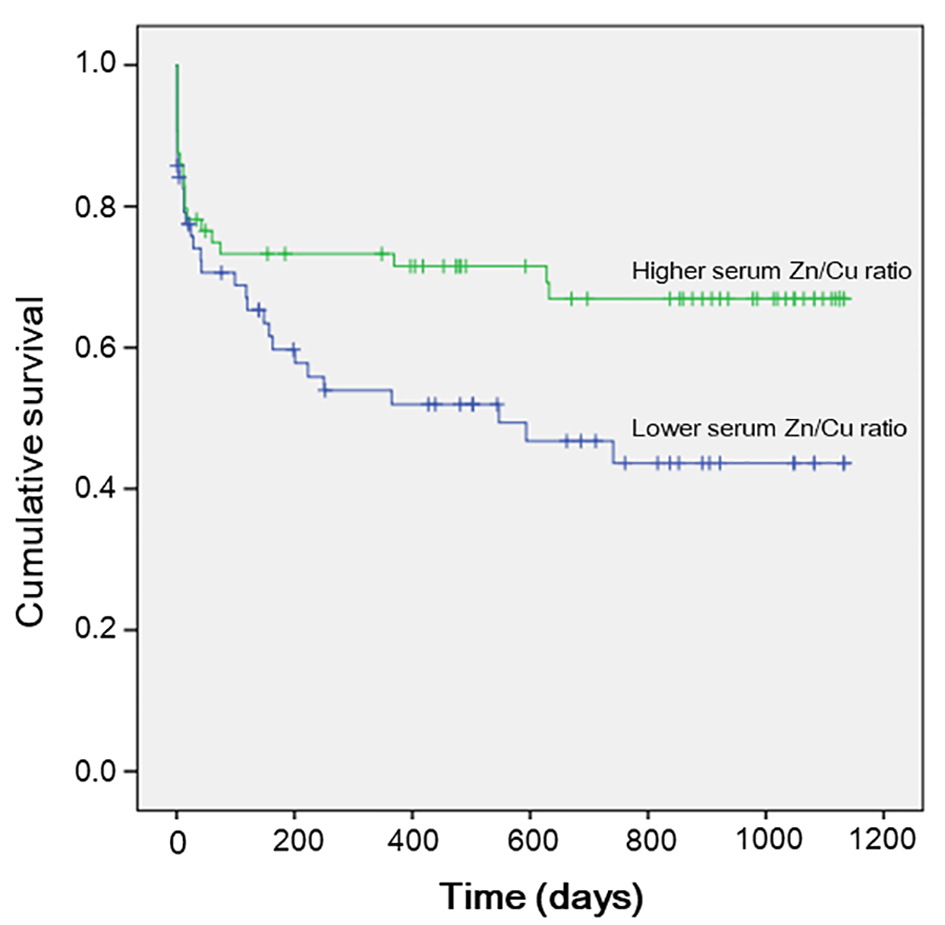| Journal of Endocrinology and Metabolism, ISSN 1923-2861 print, 1923-287X online, Open Access |
| Article copyright, the authors; Journal compilation copyright, J Endocrinol Metab and Elmer Press Inc |
| Journal website http://www.jofem.org |
Letter to the Editor
Volume 7, Number 6, December 2017, pages 199-200
Association of Serum Zn/Cu Ratio With Handgrip Strength and Hospitalization in Japanese Patients With Type 2 Diabetes
Hidetaka Hamasakia, b, c, Hidekatsu Yanaib
aHamasaki Clinic, Kagoshima, Japan
bDepartment of Internal Medicine, National Center for Global Health and Medicine Kohnodai Hospital, Chiba, Japan
cCorresponding Author: Hidetaka Hamasaki, Hamasaki Clinic, 2-21-4 Nishida, Kagoshima 890-0046, Japan
Manuscript submitted December 20, 2017, accepted December 27, 2017
Short title: Serum Zn/Cu Ratio With Handgrip Strength
doi: https://doi.org/10.14740/jem481w
| To the Editor | ▴Top |
Zinc (Zn) is negatively associated with the incidence of coronary heart diseases in patients with type 2 diabetes [1], and copper (Cu) may also play a pivotal role in the pathogenesis of diabetes [2]. We reported that the serum Zn/Cu ratio was positively associated with glycemic control in patients with type 2 diabetes [3]. In another study, patients with type 2 diabetes demonstrated lower handgrip strength, which is a useful predictor of the risk of cardiovascular disease and mortality [4], than those without diabetes [5]. The aim of this study was to examine the association of the serum Zn/Cu ratio with handgrip strength and hospitalization for glycemic control in patients with type 2 diabetes.
We conducted a retrospective cohort study on patients with type 2 diabetes who were treated at the National Center for Global Health and Medicine, Kohnodai Hospital, and the study was performed in accordance with the Declaration of Helsinki. Of the 1,303 subjects enrolled, we simultaneously measured the handgrip strength and serum levels of Zn/Cu of 131 subjects (74 men and 57 women) at baseline. Their mean age, body mass index, and hemoglobin A1c levels were 63.8 ± 12.7 years, 26.2 ± 5.8 kg/m2, and 7.8±1.9%, respectively. Their mean and median serum Zn/Cu ratios were 0.74 ± 0.25 and 0.73, respectively. The serum Zn/Cu ratio was positively associated with handgrip strength (r = 0.279, P = 0.001, by Spearman’s rank correlation coefficient). During the mean follow-up of 469 ± 425 days, 55 patients (42%) were admitted to the hospital for glycemic control. Kaplan-Meier survival analysis confirmed a negative association between the serum Zn/Cu ratio and risk of hospitalization for glycemic control (P = 0.031) (Fig. 1).
 Click for large image | Figure 1. Kaplan-Meier survival analysis of serum Zn/Cu ratio for hospitalization. Subjects were divided into higher and lower serum Zn/Cu ratio groups on either side of the median. |
To my knowledge, this is the first study to demonstrate a significant association of the serum Zn/Cu ratio with handgrip strength and hospitalization in patients with type 2 diabetes. Mocchegiani et al [6] reported an unfavorable association of the serum Cu/Zn ratio with physical parameters, including handgrip strength and mortality, in elderly subjects. Although serum levels of Zn and Cu are influenced by numerous factors, such as the nutritional status and comorbidities [3, 6], an adequate Zn/Cu ratio has the potential to ameliorate glycemic control and improve physical functions. However, this is a small-scale, retrospective, observational study; thus, further investigations are needed to understand both the effect of serum Zn/Cu ratio on glycemic control and its underlying mechanism of action.
Acknowledgments
The authors appreciate the support of Clinical Research Center, National Center for Global Health and Medicine Kohnodai Hospital.
Competing Interests
No potential competing interests relevant to this paper were reported.
| References | ▴Top |
- Chabosseau P, Rutter GA. Zinc and diabetes. Arch Biochem Biophys. 2016;611:79-85.
doi pubmed - Tanaka A, Kaneto H, Miyatsuka T, Yamamoto K, Yoshiuchi K, Yamasaki Y, Shimomura I, et al. Role of copper ion in the pathogenesis of type 2 diabetes. Endocr J. 2009;56(5):699-706.
doi pubmed - Hamasaki H, Kawashima Y, Yanai H. Serum Zn/Cu Ratio Is associated with renal function, glycemic control, and metabolic parameters in Japanese patients with and without type 2 diabetes: a cross-sectional study. Front Endocrinol (Lausanne). 2016;7:147.
doi - Hamasaki H, Kawashima Y, Katsuyama H, Sako A, Goto A, Yanai H. Association of handgrip strength with hospitalization, cardiovascular events, and mortality in Japanese patients with type 2 diabetes. Sci Rep. 2017;7(1):7041.
doi pubmed - Sayer AA, Dennison EM, Syddall HE, Gilbody HJ, Phillips DI, Cooper C. Type 2 diabetes, muscle strength, and impaired physical function: the tip of the iceberg? Diabetes Care. 2005;28(10):2541-2542.
doi pubmed - Mocchegiani E, Malavolta M, Lattanzio F, Piacenza F, Basso A, Abbatecola AM, Russo A, et al. Cu to Zn ratio, physical function, disability, and mortality risk in older elderly (ilSIRENTE study). Age (Dordr). 2012;34(3):539-552.
doi pubmed
This article is distributed under the terms of the Creative Commons Attribution Non-Commercial 4.0 International License, which permits unrestricted non-commercial use, distribution, and reproduction in any medium, provided the original work is properly cited.
Journal of Endocrinology and Metabolism is published by Elmer Press Inc.
